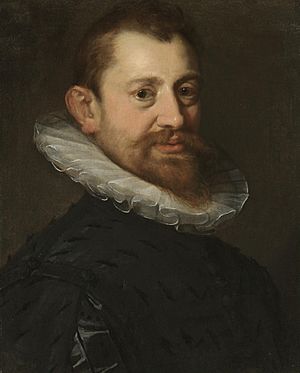Adriaen de Vries facts for kids
Quick facts for kids
Adriaen de Vries
|
|
|---|---|

Portrait by Hans von Aachen
|
|
| Born | Circa 1556 |
| Died | 1626 |
| Known for | Sculpting |
| Style | Northern Mannerism |
Adriaen de Vries (born around 1556, died 1626) was a very famous sculptor. He was born in the Netherlands but worked mostly in Central Europe.
His art style was called Northern Mannerism. It also showed early signs of the Baroque style. He was excellent at shaping models and casting them in bronze. He was also great at using patina, which is the greenish layer that forms on old bronze. Many people thought he was the best European sculptor of his time. He was also very good at drawing.
After he died, Adriaen de Vries didn't have any direct students who followed his style. This was partly because of the Thirty Years' War, which caused a lot of trouble. Art styles also changed a lot during that time.
Contents
Life of Adriaen de Vries
Adriaen de Vries was born in The Hague. His family was important and wealthy. We don't know much about his early art training. Some people think he learned from Willem Danielsz van Tetrode. Tetrode was a student of the famous Italian artist Benvenuto Cellini. Another idea is that de Vries learned from his brother-in-law, who was a goldsmith. Both ideas suggest why de Vries was so skilled at casting bronze and making his sculptures look perfect.
Learning in Italy
De Vries traveled to Florence, Italy. By 1581, he was working in the studio of Giambologna. Giambologna was a master of the Mannerist style and a big influence on de Vries's later work. Like de Vries, Giambologna was also from Northern Europe.
De Vries helped Giambologna with some sculptures for a chapel in Genoa. In 1586, he went to Milan to help Pompeo Leoni. Pompeo's father, Leone Leoni, was a very important bronze caster. De Vries took over his large studio. For Leoni, de Vries made three large statues of saints for a church in Spain.
Working for Princes and Emperors
After his time in Milan, de Vries briefly worked for Charles Emmanuel I, Duke of Savoy in Turin. Then, from 1589 to 1594, he worked in Prague for Emperor Rudolf II. He made busts (head and shoulder sculptures) and reliefs (sculptures that stick out from a flat surface). These works can now be seen in Vienna and at the Victoria and Albert Museum in London.
In 1594, he left Prague to study in Rome. On his way back through Germany, he created two fountains for the city of Augsburg in 1596. These fountains, called Mercury and Hercules and the Hydra, can still be seen today.
Return to Prague
De Vries went back to Prague in 1601. Emperor Rudolf II made him his "chamber sculptor." This meant he was a special artist for the emperor. Around 1604, he created a statue of Christ at the column. This statue was part of a larger group for a tomb. Today, it is in the National Museum in Warsaw.
De Vries stayed in Prague even after Emperor Rudolf died in 1612. He lived there until his own death in 1626. During this later period, he found a new supporter in Prince Karl I of Liechtenstein. He also received orders for sculptures from other German rulers. One important work was a group of statues for a mausoleum in Stadthagen. This is the only work by de Vries that is still in its original place. He also made a fountain for the King of Denmark's palace, Frederiksborg Palace. One of the statues from this fountain is now in the Rijksmuseum.
Famous Works
The Rijksmuseum in the Netherlands has two sculptures by de Vries. One is a bronze relief of Bacchus and Ariadne. The other is a statue called Bacchant, which was bought in 2014. De Vries was not very well known in his home country until an exhibition in 1999.
The largest collection of de Vries's work is at Museum De Vries in Drottningholm Palace in Sweden. This museum opened in 2001. These sculptures ended up in Sweden because of the Battle of Prague (1648). During this battle, the Swedes took many treasures from Emperor Rudolf's collections. They also took many garden statues from a palace in Prague.
The original statues are now in Museum de Vries. However, you can see bronze copies of them at the Wallenstein Palace in Prague. Another famous work by de Vries at Drottningholm is the Neptunus Fountain. This fountain was originally made for Frederiksborg Palace in Denmark. These sculptures were also taken by Sweden during a war.
Gallery
-
Bust of Emperor Rudolf II, 1607. It is now in Imperial Treasury, Vienna.
-
Resurrection monument (a cenotaph) in the mausoleum of Prince Ernst of Schaumburg. This was made between 1613 and 1620.
See also
 In Spanish: Adrián de Vries para niños
In Spanish: Adrián de Vries para niños



